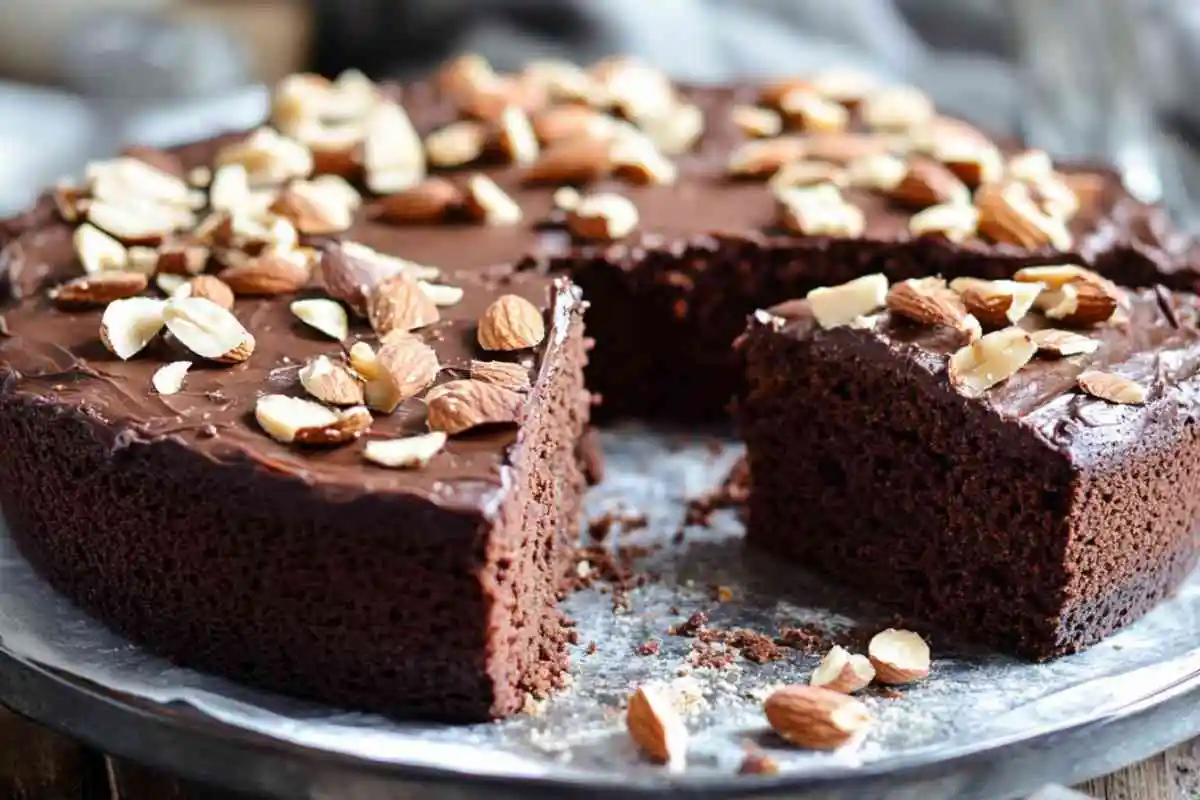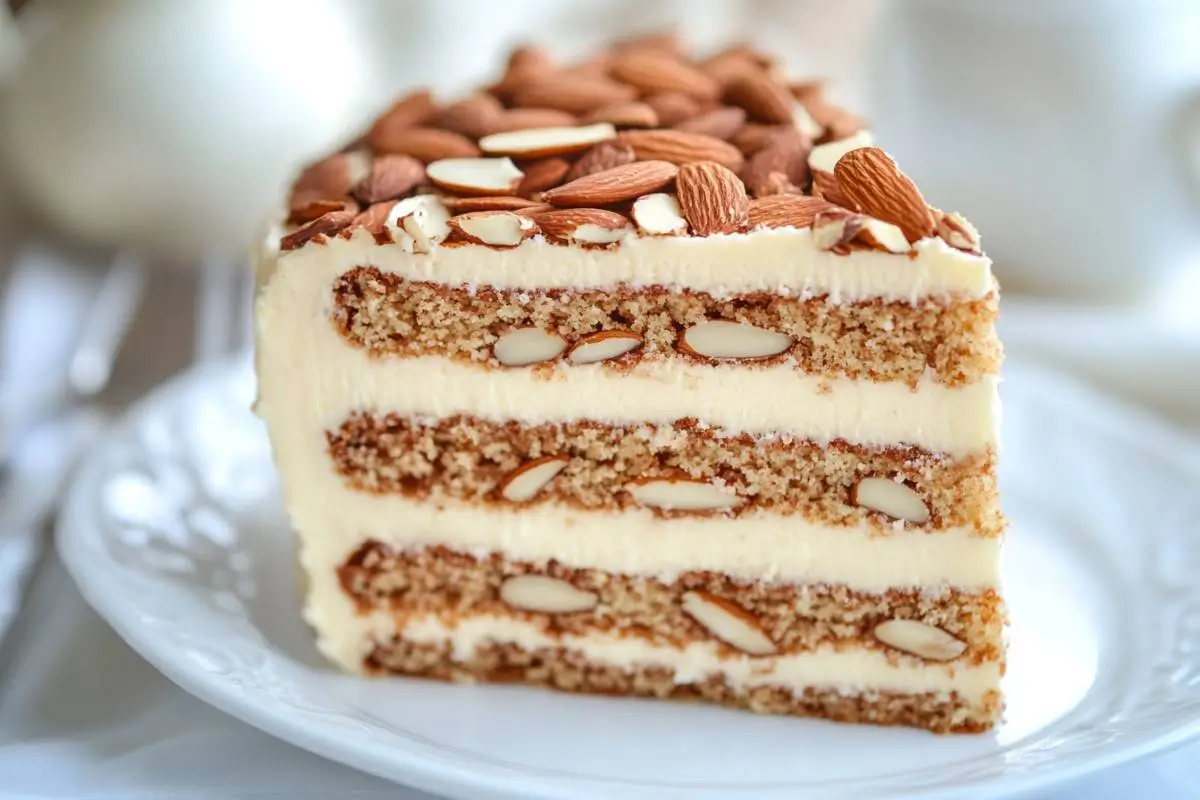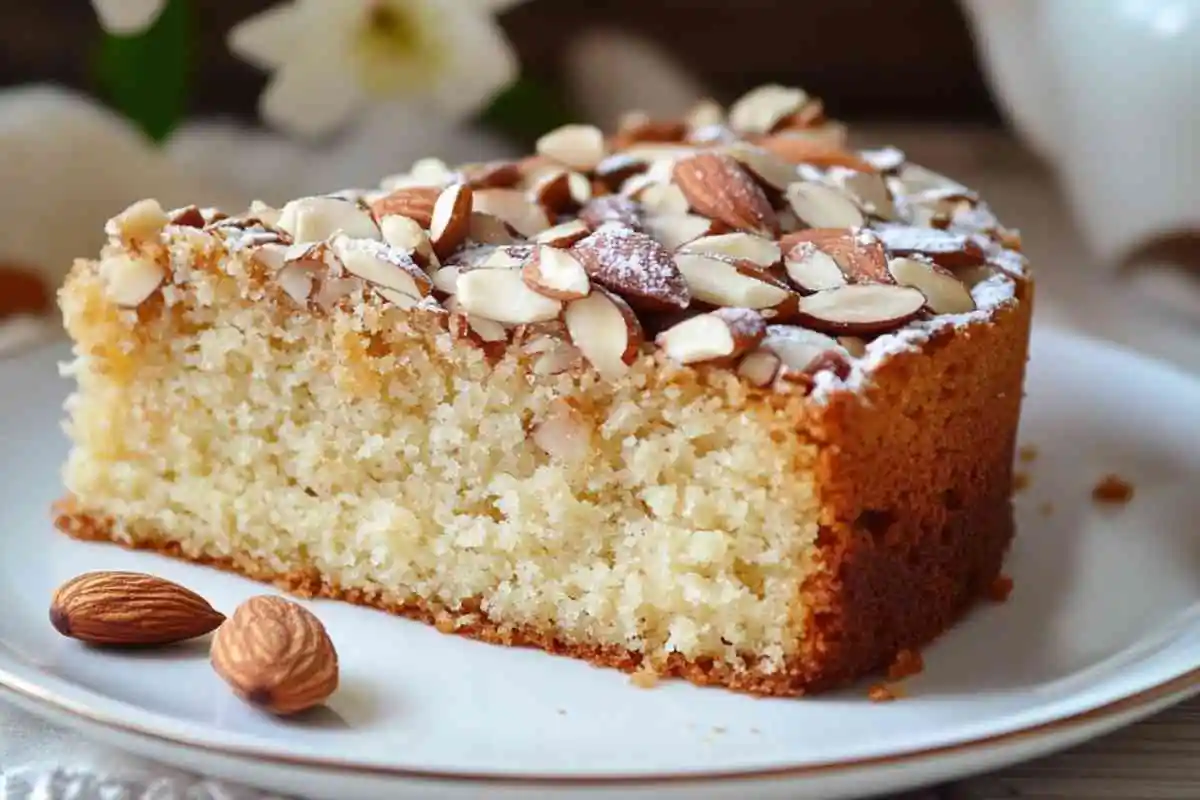The almond cake recipe you’ve been searching for is finally here! This delightful dessert combines rich, nutty flavors with a soft, moist texture that’s guaranteed to please.
Whether you’re preparing a sweet treat for a special occasion or simply indulging in a moment of self-care, this recipe has everything you need for success.
In this guide, we’ll take you step by step through crafting the perfect almond cake recipe.
From selecting the finest ingredients to troubleshooting common baking challenges, you’ll learn the secrets to creating a dessert that’s both simple and elegant.
Plus, we’ll share creative variations to make this cake uniquely yours. Ready to bake something unforgettable? Let’s dive in!
Why This Almond Cake Recipe Is a Must-Try
The almond cake recipe is more than just a dessert—it’s a celebration of flavor, texture, and versatility.
Whether you’re an experienced baker or a beginner, this recipe promises exceptional results with minimal effort.
A Nutty Delight for Every Occasion
This almond cake recipe is perfect for any event, big or small. Need a dessert for a formal dinner?
Pair it with a drizzle of honey or a citrus glaze. Hosting a casual gathering?
A simple dusting of powdered sugar will do the trick. Its adaptability makes it a favorite for birthdays, holidays, and everything in between.
The natural sweetness of almonds, combined with the buttery crumb, creates a flavor profile that’s both indulgent and balanced. It’s the kind of dessert that leaves everyone asking for seconds.
Simple Ingredients, Incredible Flavor
This almond cake stands out because it transforms simple pantry staples into a dessert that feels truly indulgent.
Almond flour and toasted almonds bring a warm, nutty flavor, while eggs and butter create a rich, tender crumb.
Add a splash of vanilla or almond extract, and you’ve got a cake that tastes as if it came from a high-end patisserie.
Essential Ingredients for Almond Cake

Using quality ingredients is key to achieving the perfect balance of flavor and texture in your almond cake.
To achieve that perfect balance of nutty richness and moist texture, each component plays a vital role.
Let’s explore what you’ll need and how to get the best results.
Almond Flour vs. All-Purpose Flour
Almond flour is the key to this recipe’s signature flavor and texture. It provides a nutty richness that all-purpose flour simply can’t replicate.
You can use almond meal, but almond flour’s finer grind creates a smoother batter and more delicate crumb.
If you’re blending almond flour with all-purpose flour, aim for a 1:1 ratio for a perfect balance of moisture and structure.
If you’re looking for more ways to bake with almonds, explore our guide filled with helpful tips and creative cake ideas.
Sweeteners and Flavor Enhancers
Granulated sugar is the classic choice for this recipe, offering a neutral sweetness that lets the almond flavor shine.
For added depth, consider swapping half the sugar for brown sugar or a touch of honey. To elevate the flavor, a splash of vanilla extract is a must. If you want to emphasize the nutty notes, a few drops of almond extract work wonders.
Dairy and Eggs for Structure
Butter and eggs are the backbone of any good cake recipe, and the almond cake recipe is no exception.
Butter adds richness and ensures a tender crumb, while eggs provide structure and help bind the ingredients together.
For a dairy-free alternative, substitute butter with coconut oil or a plant-based option.
Step-by-Step Guide to Baking Almond Cake

Baking a delicious almond cake is simpler than it seems—all it takes is the right technique and a little practice.
Follow these steps, and you’ll end up with a dessert that’s both stunning and delicious.
Preparing Your Ingredients
Start by measuring your ingredients accurately. Toast your almonds lightly in a dry skillet for an added layer of flavor, then let them cool before grinding into a fine meal if you’re not using pre-made almond flour.
Mixing the Perfect Batter
Start by beating the butter and sugar in a large bowl until the mixture becomes pale and airy.This step is crucial for creating a tender cake texture.
Crack in the eggs one by one, ensuring each is well incorporated before adding the next. Mix in the vanilla and almond extracts to enhance the flavor.
In another bowl, whisk together the almond flour, all-purpose flour (if using), baking powder, and a small pinch of salt to evenly distribute the dry ingredients.
Gradually incorporate the dry ingredients into the wet mixture, alternating with milk to keep the batter smooth and pliable.
Mix gently until just combined to avoid overworking the batter, which can lead to a heavy texture.
Baking and Cooling Tips
Set your oven to 350°F (175°C) and prepare a 9-inch round cake pan by greasing it or lining it with parchment paper. Evenly spread the batter in the pan, then bake for 30–35 minutes.
The cake is done when a toothpick inserted in the center comes out clean. Let it rest in the pan for 10 minutes before moving it to a wire rack to cool completely.
This ensures it sets properly and avoids breaking.
Want to achieve flawless baking results? Check out our guide on buttery, golden perfection for expert tips on even cooking.
Common Mistakes and How to Avoid Them

Even seasoned bakers can encounter challenges when making the almond cake recipe. The good news?
With a little knowledge, you can sidestep these common pitfalls and achieve flawless results every time.
Overmixing the Batter
A common mistake is overmixing, which can lead to a dense and tough cake.
While it may be tempting to keep stirring until everything looks perfectly smooth, overmixing can develop the gluten in all-purpose flour (if used), resulting in a dense and tough cake.
How to Avoid It:
Gently fold the dry ingredients into the wet mixture, stopping as soon as everything is blended.
Use a spatula for gentle folding instead of a mixer once the flour is added.
Remember, a few lumps are okay—they’ll smooth out as the cake bakes.
Choosing the Wrong Pan
The type and size of your pan directly impact how your almond cake recipe turns out. A pan that’s too large may result in a flat cake, while one that’s too small could cause overflow and uneven baking.
How to Avoid It:
Stick to a standard 9-inch round pan for best results. Grease the pan thoroughly with butter or oil, and line the bottom with parchment paper to prevent sticking.
Overbaking or Undercooking
Timing is everything. Overbaking will dry out your cake, while underbaking leaves it gummy in the center.
How to Avoid It:
Set a timer for the lower end of the baking range (30 minutes) and check for doneness. Test the cake for doneness by inserting a toothpick into the center—if it comes out clean or with a few soft crumbs, it's ready to come out of the oven.
Avoid opening the oven too often during baking, as this can cause uneven cooking.
For more baking precision, check out tips from our almond nut cake recipe guide to refine your techniques.
Creative Variations of Almond Cake

One of the joys of baking is experimenting with flavors, and the almond cake recipe is a versatile canvas for creativity. Whether you prefer something indulgent or fresh, these variations will inspire you to customize your cake.
Chocolate Almond Cake
For a rich, chocolatey variation, mix in two tablespoons of cocoa powder with the dry ingredients and gently fold a handful of chocolate chips into the batter.
The rich chocolate pairs beautifully with the nutty flavor of almonds, making this version perfect for chocoholics.
Lemon-Almond Cake
For a refreshing twist, incorporate the zest of one lemon and 2 tablespoons of fresh lemon juice into the batter.
After baking, drizzle the cake with a lemon glaze made from powdered sugar and lemon juice. This variation is bright, tangy, and perfect for spring or summer gatherings.
Gluten-Free and Dairy-Free Options
To create a gluten-free almond cake, swap all-purpose flour for a gluten-free baking blend or use only almond flour for a naturally grain-free option.
For a dairy-free version, replace butter with coconut oil or a plant-based alternative and use almond milk instead of regular milk.
Coconut-Almond Cake
Add 1/2 cup of shredded coconut to the batter for a tropical twist. Sprinkle extra coconut on top before baking for a golden, toasted topping.
Pair this variation with a dollop of whipped cream for a dessert that feels like a mini getaway.
For more creative dessert ideas, visit our honey butter toast guide to see how simple ingredients can lead to extraordinary results.
Nutritional Information (Per Slice)

Macronutrients
Vitamins
Minerals
Optional Adjustments for Variations
- 1Chocolate Almond Cake : Adds ~50 calories and 3g sugar per serving if chocolate chips or a ganache is included.Increases iron and magnesium content due to the cocoa.
- 2Lemon Almond Cake: Adding lemon zest and juice enhances flavor and vitamin C content without significantly increasing calories. A simple lemon glaze made with powdered sugar and juice contributes about 25 extra calories per serving..
- 3Coconut-Almond Cake : Adds ~40 calories and 3g fat per serving due to shredded coconut.Improves manganese and selenium levels, important for metabolic function.
Key Considerations
Conclusion
The almond cake recipe is more than just a dessert—it’s a testament to how simple ingredients can create something truly extraordinary.
With its rich, nutty flavor, moist texture, and endless versatility, this cake is perfect for any occasion, from casual brunches to festive celebrations.
Whether you stick to the classic version or experiment with creative variations like chocolate, lemon, or coconut, this recipe offers something for everyone. And thanks to our step-by-step guide and helpful tips, you’ll feel confident every step of the way.
So what are you waiting for? Gather your ingredients, preheat your oven, and treat yourself (and your loved ones) to the irresistible charm of the almond cake recipe.
Don’t forget to share your creations and let us know which variation you love the most!
For more baking inspiration and delicious ideas, check out our guides to almond nut cake recipe and honey butter toast. Happy baking!
Almond Cake Recipe FAQs
Yes, almond meal is a suitable substitute, but it will result in a slightly coarser texture. Almond flour is made from blanched almonds and has a finer consistency, making it ideal for achieving a smooth, tender crumb. If you use almond meal, consider sifting it to remove larger pieces for better results.
Almond cake is best stored in an airtight container at room temperature for up to 2–3 days. If you’d like to keep it fresh for longer, refrigerate it for up to a week. For extended storage, freeze the cake in slices, tightly wrapped in plastic wrap, for up to 3 months. Thaw overnight in the refrigerator before serving.
Yes, Absolutely! You can make a delicious vegan almond cake by using plant-based ingredients. Substitute eggs with flax eggs (1 tablespoon of ground flaxseed mixed with 3 tablespoons of water per egg) and replace butter with a plant-based alternative like coconut oil or vegan margarine. Keep in mind that the texture may be slightly different, but the flavor will remain delicious.
This cake is versatile and can be dressed up or kept simple. Dust it with powdered sugar for an elegant finish, drizzle it with a citrus glaze for a tangy twist, or top it with fresh berries and whipped cream for a luxurious presentation. For a more indulgent option, try adding a layer of chocolate ganache.
Absolutely! While almonds are the star, adding finely chopped walnuts, hazelnuts, or pistachios can enhance the flavor and texture. Sprinkle some nuts on top of the batter before baking for a crunchy topping that complements the soft cake.
When baking a new recipe like the almond cake recipe, it’s natural to have a few questions.

